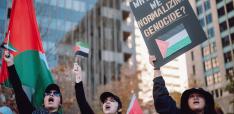Documentary Reveiw: El Poeta

El Poeta, directed by Katie Galloway and Kelly Duane de la Vega, Loteria Films, 2015. 55 minutes, distributed by Bull Frog Films, DVD ISBN 1-94154-546-7
On March 28, 2011, seven people were found dead inside a car on the highway Cuernavaca-Acapulco. One of them was a 24-year old man, Juan Francisco Sicilia, the son of the renowned Mexican journalist and poet Javier Sicilia. The event could have passed as just another news story in the spiral of violence afflicting this country since President Felipe Calderón launched the war on drugs in 2006. But the determination of Sicilia to demand justice for his son, and for his country, made this the trigger of a national movement to restore dignity and put a name and a face to every victim of this war.
This film by Katie Galloway and Kelly Duane de la Vega tells the story of the personal and political journey of the poet, Javier Sicilia, after the death of his son. It is an intimate look at the human, philosophical and spiritual dimensions of a man who wrote his last poem to his lost son because “there is no sense in writing poetry in a world like this.” Using powerful images and through interviews with people close to Sicilia, his family and the movement he contributed to create, it tells a compelling story about Mexico and the pain and hopes of its citizens.
By 2011, as the film tells us, it was estimated that more than 40,000 people had died, and thousands more disappeared amidst the climate of terror, retaliation, and impunity that characterized Mexico’s war on drugs. The strategy, based on the deployment of the military to fight the drug cartels, had focused on the leadership of the groups. Famous figures were killed, captured and sometimes extradited to the US. Most of the cartels fragmented amidst bloody fighting for power, and extreme violence became the tactic of choice within and among them, and against the state. With deeply corrupted police forces and authorities, and an inefficient justice system, impunity became the norm. It became a mantra of Calderón and the rest of his administration that the vast majority of the victims had something to do with crime. Those who dared to ask about the fate of their loved ones faced silence and often new threats from the cartels and the authorities.
It was precisely this assertion, that added humiliation and further victimization to the plight of innocent people, which Sicilia defied: “My son was an innocent. He shouldn’t have died”. Soon after his son’s death, Sicilia published an open letter to the Government and criminals. The inability of the authorities to provide justice triggered his call for Mexicans to unite, take to the streets, and to demand justice and an end to violence. Many others felt compelled by the personal dimension of his claim and responded to this call after years of silence and fear.
The different stages of the movement for peace so created are beautifully depicted in this film. First, the mobilization in Cuernavaca, where people joined to share stories of their beloved ones, forgotten and criminalized by the authorities. Then there was a march to Mexico DF, joined by more than 150 organizations and thousands of people. More than 150,000 persons concentrated in the Zócalo (the main square in Mexico City, bordered by the headquarters of the state institutions, and the cathedral). Families and friends read the names of victims; fountains were painted in red: “No more blood.” The Movement for Peace with Justice and Dignity presented a five-point manifesto, the Pact for Justice, demanding truth and justice for victims; an end to militarization; a fight against corruption; tackling the economic roots of organized crime, and a new social policy based on education for young people.
The moral stature of Sicilia and the dimensions of the mobilization finally captured the attention of political actors including the president and the parliament. However, government responses followed the familiar path of empty promises to deliver justice: Calderón met Sicilia, offering his condolences but refusing to change the political strategy. A new Caravan for Peace marched to the north of Mexico, the territories most affected by the war on drugs, and drew more attention to the scope of the tragedy unfolding in the country and the abandonment of its victims. Later on, it moved to the US, from San Diego to Washington DC, to demand an end to the catastrophic drug war.
Little has changed since then. Mexico has seen new mobilizations, such as those demanding truth and justice for the 43 students who disappeared in September 2014 in Ayotzinapa. A presidential election put into office a new administration headed by Enrique Peña Nieto, with the promise of a change in the security strategy. But the massacres, revenge, violence and corruption continue. In August 2015, the Mexican National Institute of Statistics and Geography estimated that more than 160,000 people had died violently in the country since 2007. This is more than the combined figures of Afghanistan and Iraq. According to Mexico’s National Register of Missing and Disappeared People, over 27,000 people are officially recognized as disappeared between 2007 and the end of 2015. Different sources put the number of those forcibly displaced by violence between 200,000 and 500,000, and the Inter-American Court of Human Rights has demanded from the Mexican Government an adequate and human-rights based response to this phenomenon.
Today, a movement calling for a change in international drug policies and an end to the US war on drugs is gaining momentum, and some countries are moving toward (still limited) reforms, including legalization of the recreational use of marijuana in some US states. But in Mexico, the war goes on. The country has become one of the primary victims of a failed anti-drugs strategy set up a few decades ago that has caused violence, marginalization and high levels of corruption, without achieving one of its primary goals: ending drug consumption.
These are the raw facts. What Sicilia does, and this film powerfully captures, is to translate the facts into a moving portrayal of human tragedy and the opportunity to reclaim a country captured by vested interests of criminals and politicians. The poet’s vision of life as an endeavor in which poetry, politics, and religiosity are permeated by a powerful ethical and spiritual dimension, is the basis of a call, then transformed into a movement, to restore Mexico as a country where people have hopes and dreams.
Mabel González Bustelo is an international advisor and consultant in peace and security, and Fellow of the Global South Unit for Mediation (BRICS Policy Center, Brazil).


